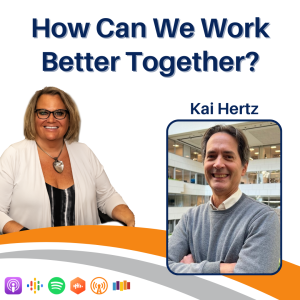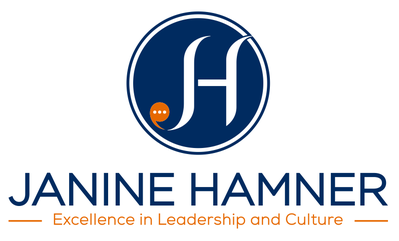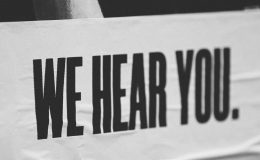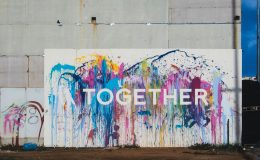
What’s the connection between your management team and staff? Could that relationship be more clearly defined, more beneficial, and more open? In this episode, Janine Hamner Holman sits down with Kai Hertz, a specialist in staff communication and relationship building, to discuss the importance of a staff association for every organization.
HOST: Janine Hamner Holman | [email protected] | LinkedIn, Facebook, Instagram
Welcome to The Cost of Not Paying Attention. I’m your host, Janine Hamner Holman. Our guest for today is Kai Hertz. I got to know Kai a little over a year ago when I was brought in by his organization to help them with psychological safety. I’m so excited to welcome Kai to the show.
Kai studied Political and Administrative Sciences at Constance University in Germany after completing his master’s degree. He then pursued a job at the World Bank. In 1997 he started working at the Inter-American Development Bank as a lead specialist in the area of grants and co-financing.
Since last April of 2023, Kai has been the President of the Inter-American Development Bank Staff Association. That organization brought me in to help with psychological safety at work. Kai, welcome to the show.
What’s one thing you have noticed the team at IDB has been failing to pay attention to? What’s the problem that inattention is causing?
Thank you for having me on this interesting podcast of yours. It was a pleasure having you a couple of months ago at the psychological safety event. My first thought was the staff association as a structure within the bank shouldn’t be an afterthought. It should be something. There’s a structure and we need to use it.
Why am I putting so much emphasis on this? I’d like to go back to the value added of a staff station or before we started having a staff station of unions. I’ll go back to the value of unions, from what I learned at my university as a student. One of my economic history professors said the rise of capitalism in England was the result of collective bargaining power. The staff position, in the end, represents collective bargaining power.
In the beginning, there was no organized labor, and there were no unions. Workers went on strike to demand better living conditions and pay. Because of these movements, labor conditions and hourly wages improved.
The owners of the means of production were sharing part of the profits with the labor force, which in turn increased demand, created better labor conditions, and contributed to improvements and productivity. The owners of the machinery and capital wanted to see it as well.

It is because of these worker movements and the subsequent establishment of unions that capitalism was successful. My point is the struggle between owners of capital and workers created a win-win situation, which has led to the advanced Western societies in which we live today.
Fast forward to the IDB Staff Association where we collectively represent the interest of our members and enable this collective power between the employees of the bank and the bank’s management team at all levels, from the board of executive directors to the president to the vice president and managers.
That’s a positive thing. History has shown us it’s a positive thing. There was an interesting article in the Financial Times about good conflict and how organizational culture needs a good healthy conflict, which in turn is related to good leadership and the ability to manage conflict.
One of the things you’re pointing to that I love is this idea we, unfortunately, have that we are all living in a world where it feels like it’s us versus them. Whoever the us is and whoever the them is, we’re in this world of polarization. We think about workers and workers’ rights, and then we think about organizations and the kinds of things organizations are trying to do, not least among them, create profit for whoever it is they’re creating profit for.
The reality is when you think about a company, a nonprofit organization, an association, whatever the organizational structure is, there is nothing that an organization can get done without its employees. The employees are the heart of the organization, they are the customer-facing part of the organization. They are what makes the organization work, and they’re what creates the profits.
We’ve created this false us versus them concept. I love that what you are doing is saying no, it’s an us and them, it’s us together. It’s the staff and the organization that makes something strong, which is a key part of the history of labor unions both in the United States and around the world.
Absolutely, Janine. The establishment brings different perspectives to the table. It invites the administration not only to look at numbers… usually if you go to the vice presidency of finance and of course the upper management as well, they always look at numbers. Numbers have an impact on the efficiency criteria and so on.

We forget people make numbers happen. People are the driving force of any organization, and the way people are being treated has a tremendous impact on the success and profitability of an institution. Happy employees or the lack thereof can make a perfect institution. If you don’t pay attention to this deposition, it can become costly for an institution. I’ll give examples from IDB.
People who recently joined the bank aren’t aware of it. They see this, and this has been there forever since they joined the bank.
The bank in the previous building on 17th Street in Washington DC didn’t have a cafeteria. They moved to this building at 13 New York Avenue. I don’t know if you’ve been here ever, but during negotiations, the cafeteria came about.
Now on the seventh floor, we have a nice cafeteria for the staff to enjoy. We don’t have to go outside to grab a bite. There’s everything in-house and at an affordable price. That’s something that was accomplished in negotiations between the staff association and management.
Another great benefit is the gym. We have a gym in the basement and what used to be just a collection of some old equipment now is a top-of-the-line gym facility where you also have access to specific training, yoga, and regular gym workouts.
One more example, because it’s important here, especially for the female population is daycare. We have a daycare facility within the bank’s building and that is key. You have your kids in good hands, you want to see them, you’re an elevator click away from your office and you can see your kids.
That’s what I call contributing to work-life balance. You mentioned work-life harmony. It’s exactly that, what it feeds into. Those examples show the value added by this positive relationship between management and the staff station. It’s not we against them, it’s us together doing great things.
Part of what I love about that is one of the things organizations are looking at is the concept of organizational wellness, which in large part is about the health and wellness of their employees. That said, it’s not only about giving healthcare, it’s also about taking care of the hearts and minds of our people.
The reality is we’ve all been going through years of tumult and perpetual change and it’s very difficult for human beings to manage. I love that part of what you’re doing is creating… you touched on three key things.
You’re creating a way for people to get good, healthy, warm food easily at work. You’re creating places for people to burn off some of the stress or work out some of the stress created by being at work. You’re creating a space where people’s children can come and be taken care of so mom or dad don’t have to worry about their kids and can pop down and check on them.
I don’t know if that was by design. Those three examples you pointed to… when we think about having healthy organizations, part of what we get to think about is how we help support the health and wellness of our people.

Depression has skyrocketed, anxiety has skyrocketed, and rates of young children thinking about doing the unthinkable and taking their own lives have skyrocketed over the last number of years. Creating space where families can be together more, where mom and dad can pop down and see their kids, and where mom and dad can take care of themselves over the day while still at work is beautiful. I love it.
I love having guests here where we get to highlight the good things organizations are doing. In particular, in the case of IDB, the staff association has a key role in ensuring those things that are critical to the health and welfare of the employees of the bank get created.
It’s exactly that, Janine, that we did it together. I don’t want to downgrade the human resource department, but I think the human resource department can only go so far.
That’s what I wanted to get into next. Some organizations have unions, but many organizations have human resources departments. Can you differentiate a little for us between what HR can do, what a staff association or union can do, and what the limitations and opportunities are?
Yes. To give a little background on the number of members we have, about 70% to 75% of people working at the IDB are members of the staff station. This is a significant number of people and they’re not only junior staff. They’re from all over the place, from all over the administration, be it high-level, mid-level chiefs, and so on.
Everybody is in that group as well. This is good news because we continue to be attractive to people from different levels of hierarchy and power within the institution. There is an implicit value add the staff association offers. We have clubs, we provide legal advice. We do the kind of advocacy I mentioned, the youth, the daycare, and more. That’s our advocacy, the results of our advocacy activities.
From my perspective, the HR department has a purpose to service the human employees of the IDP. It’s an important role to manage human resources at any institution, not only at the IDB. IDB faces challenges, such as building an image of an honest broker, not only representing the interest of the bank’s management but also of its employees.
There’s no doubt the HR department in coordination with other bank departments at the IDB, offers a series of career-advancing opportunities. We have training courses, leadership workshops, and so on. Those are great inputs for people in management positions and some lead functions. Those are all actions or platforms they provide for staff in good times.
When the going gets rough, where do you go? The staff position has an intrinsic value here as well. The purpose is to promote the well-being of its members. There are no questions asked of us, such as “What are you in good times or bad times?” That’s always our mission.
The good thing is the HR Department also offers leadership skills and training to enhance leadership skills. People can learn those skills and provide greater empathy. That is a good thing. Empathy can be learned. The bank is offering those courses as well. In addition to these courses, we ourselves need to take action too.

We as employees need to take action too. All of us who are not necessarily in a leadership position can also do our part. We are quick at pointing fingers at others. We fail to look at ourselves.
The other day over the Christmas period, I read an interesting book by Shawn Achor called The Happiness Advantage, which provides evidence that our mindset is crucial. Our mindset has a critical impact on our overall happiness.
As he describes in the book, the mindset is the mental construction of our daily activities is more than the activity itself that defines our reality. He ran tests on this theory. What we think defines how we in the end feel and how we produce. We need to have both sides taken into consideration.
This idea of mindset, on the one hand, can feel sort of woo-woo. We can feel our attitude creates what we bring to us and blah, blah, blah. However, the science of neurobiology has taught us the lens we see things through entirely shapes our perception of reality.
Everybody talks about three realities. There’s my reality, there’s your reality, and there’s what happened because I see it through the lens I’m looking through. I was talking with a gentleman the other day who’s a professor at the Harvard Business School. He and I were talking about the work I do and the work he teaches.
My brain said a bad word in my brain, “Why is this human mansplaining this to me? This is what I do. I know all of this.” Then I realized, “Okay, wait, that’s the lens I’m looking through. He’s not talking down to me. He’s not mansplaining to me.”
That’s what he does. He gets up in front of lecture halls and professors. He’s not trying to belittle me, he’s not trying to belittle my experience, but that was the lens I was looking through. When I widened the focus, I wasn’t thinking of him as a jerk who was mansplaining to me, I thought of him as a Harvard Business School professor.
It created a whole new opportunity for connection and affinity, and for me to hear what he was saying because when I was dismissing him in the beginning, I couldn’t take in what he was saying.
This idea of our mindset and how we perceive things is so critical. I love that you read this book and I love that it’s part of what you’re bringing in.
You touched on employee engagement and our feelings of happiness and contentment. Much of that is connected to our mindset, our perspective. It’s also connected to actions and tangible events. When you think about your role, within the staff association, and when our readers think about the role of a labor union that might exist at their organization or what they as leaders can create at their organization… talk to me about how that all connects in together.

Going back to what you said about listening, listening is very important. You said you’re not only interpreting the words from your lens, you’re listening. When it comes to the relationship between HR or any bank administration at different levels and the staff position, we have to listen to each other and not simply project our mindset to serve our interpretation. We need to listen.
When we listen, we learn. We listen, reflect, and then become a little happier, hopefully contributing to the happiness index.
I’ll go back to Shawn Achor because I love his book. He says happiness is the center around which success orbits. If we don’t have happy staff then our institution suffers the consequences. We’re less productive and less engaged.
This thought is reflected in internal reports of the IDB. Those reports can show the main problem, the reason people aren’t happy. Partially it goes back to the leadership qualities of those in leadership positions. Thankfully, as you said, we can learn leadership. We can learn to be better leaders, and to show more empathy. In addition to that, we need to do our own job too.
We need to do our own part, and grow, and listen. In the staff association, we are connecting that to the clubs we’re offering. As a member of the staff station, we do promote clubs, be it the running club, tennis club, meditation, art, you name it. We all promote the staff association with different clubs, which provide employees with the opportunity to build social connections around common interests.
These social activities have an impact on our mindset and our happiness index. These clubs, and the gym, build this, and contribute to this community. We have positive elements influencing the way we feel and the way we experience our surroundings and behave towards others with enhanced empathy with happiness.
Through participation as a member, through participation in these social networks, you build stronger relationships which ultimately have a positive impact on the workplace environment. That’s why I see the connection between HR, the staff association, and the IDB as a whole. The pieces we offer contribute to a better work environment. There’s a win-win situation between all of us, the staff association, HR, and upper management. That is important to take into account.
Absolutely. When you talk about these clubs in many organizations, they would be an ERG, an employee resource group. Part of what’s great about those groups, in addition to the things you talked about, is it creates a sense of belonging. It creates a sense of connection.
We want diverse organizations, with diverse kinds of lived experiences, and all kinds of different perspectives that then get brought together. When we create places inside the organization where people with interests can come together for collaboration, for support, for all kinds of things, one of the things that gets created is this sense of belonging in the organization.
When we create that, when people feel, “I belong, I belong at the bank, the bank is part of my home, part of my family where my people are,” They are more connected to the work, more enthusiastic about the work, and their happiness quotient goes up.
This idea, it’s why when many practitioners like myself talk about diversity, we talk about diversity, inclusion, and belonging. The idea of having a place where we belong is so important. It’s hardwired into us as humans. It’s this idea where you started in bringing humanity back to the workplace, putting the focus on the employees, not only the products or services.
Absolutely. These communities are crucial for belonging. That’s what our clubs also promote. We have the LGBTQ+ community, we have the women’s network, and many others. Those are promoted by HR. That’s a great thing. We need these communities so people have the feeling of belonging. All these pieces contribute to a better work environment, and a positive work environment. People feel comfortable, and productive, and enjoy their workplace.
Absolutely. When you look forward, what are the exciting opportunities in front of the organization? What is the next frontier, the next opportunity you are excited to take on inside the staff association, to help create for the bank and its employees?
Currently, we have a new administration, a new president came on board about a year ago. With that change, upper management changes, and so on. There will be new institutional strategies being rolled out. There are some tensions or unknown elements we need to pay attention to in those changes.

That darn unknown, it’s so challenging.
We need to be prepared for it but prepared for it in a positive tone. Change is good and evolution takes place. We all need to take that into account. There are new elements coming on board and institutional strategy change will be happening. AI is having a greater impact on the way we work.
All these kind of trends, we need to be aware of them and see how we respond appropriately in the end. I would like to demonstrate to people who work at the bank or any other international organization… most of us are international civil servants. We are not any person who works in a private company.
If I can switch around from one employer to the other employer, we are international civil servants in that sphere, and our labor market is much more limited. I cannot simply jump around.
With all of these changes coming down the pipe, we need to take into account that we need to plan any change in a human way. You cannot replace the international service servant from one day to the other. People have been living here for 10, 15, 20 years, and have established families.
The moment they are not employed by the IDB anymore or any other international organization, basically we need to leave the country within a very short period of time. I don’t have the luxury of applying to 10 jobs or so within the same city. I need to pack my bags and leave within a very relatively short period of time.
That is a challenge, but I think we can address it through intelligent HR planning. Perhaps previous administrations haven’t considered that. It’s respect. We have here an institution, an international organization whose employment model is based on international civil servants which comes with limitations. We need to program our HR management around it.
I think it can be done. We are not a private sector company. We’re a public sector company. Our mission is long-term. We finance products that induce development in specific areas in those countries we serve in Latin America and the Caribbean. If there’s an education project, hopefully, we will have an impact on the quality of education in a given country in Latin America and the Caribbean.
These are all long-term products. These are products that have had an impact over the years. Our mission has been more or less the same over the past six years.
It’s one of those tensions because when we are now in a place in the world economy where employees have their choice, we’ve got 1.4 jobs for every person in the workforce. Yet we have… I was with a group of CEOs the other day, and the conversation turned to where have all the employees gone.
We’ve got so many people who are doing their own thing and being entrepreneurs. The pool of talented workforce feels like it has shrunk. To think differently, how do we keep the great people we currently have? How do we invest in this workforce? The pressure could be having international civil servants, and needing to ensure we don’t completely uproot their lives. Maybe it’s a for-profit company threatened by losing institutional knowledge.
It’s the back of the hand and the front of the hand. It’s all about keeping our talent engaged and happy and feeling like the organization cares about their future. The world of work has changed fundamentally over the last 20 years. What people expect from a workplace now is very different from what people expected 20, 30, or 40 years ago when I was starting my career.

When we think about the role of HR, when we think about the role of a staff association, when we think about the role of employees in an organization, we have to think differently about how to put the employee first. The mission of the organization, whether your mission is empowering people in South Central America and the Caribbean, or creating a great pair of shoes, is how to keep employees engaged so they want to stick around and do a great job.
Excellent point. That’s the combo between the HR and the staff association, we can accomplish that goal. It’s not only when a person is being hired to work at the IDB, it’s also throughout their career within the bank that we need to take care of them.
Knowledge changes. There’s always something new that comes up every five years or so. We need to refresh our knowledge and stay up to date with our technical expertise. The HR department has a very important role in making sure that happens, to keep people up to date, to keep people engaged, and to maintain this workforce. That’s crucial, to put the employee first, but the employee is not necessarily seen as first by HR.
To combine with the staff association, we probably are getting there or getting closer. In the end, the human, and employee resources within the bank are treated in such a way they feel comfortable, they feel embraced. They feel that not only can I do their job correctly, but they have other supporting programs that allow them to be engaged, productive, and happy at the workplace.
The combination of the staff association and the HR is where we can create this win-win situation. That goes back to your first question, it’s the cost of not paying attention to the staff association. We miss out on opportunities where we would have a win-win situation if we engaged together to solve different issues. If we work together, if we listen to each other, we can accomplish great things.
When we work together, when we listen to each other, we can accomplish great things. Thank you Kai so much. Thank you for your wisdom. Thank you for your insights. Thank you for the great work you are doing with the staff association and the great work the bank is creating worldwide. It has been a joy and a privilege to have you here.
Thanks for inviting me, Janine, it’s my pleasure.
I am Janine Hamner Holman, and this has been The Cost of Not Paying Attention. Remember, great leaders make great teams. Until next time.
Important Links
The Happiness Advantage by Shawn Achor
About Kai Hertz
 Currently President of the IDB Staff Association, Kai has been working at the Bank for over 20 years. He grew up in Caracas, Venezuela, and upon completion of high school, studied Political and Administrative Sciences at Konstanz University, Germany. With the completion of his Master’s degree, he pursued his first job at the World Bank, and in 1997, he started working for the IDB as a Lead Specialist in the area of grants and co-financing. He received an award for promoting youth development in Latin America and the Caribbean from the IDB-Youth Program. Kai enjoys multicultural environments and is committed to work-life balance.
Currently President of the IDB Staff Association, Kai has been working at the Bank for over 20 years. He grew up in Caracas, Venezuela, and upon completion of high school, studied Political and Administrative Sciences at Konstanz University, Germany. With the completion of his Master’s degree, he pursued his first job at the World Bank, and in 1997, he started working for the IDB as a Lead Specialist in the area of grants and co-financing. He received an award for promoting youth development in Latin America and the Caribbean from the IDB-Youth Program. Kai enjoys multicultural environments and is committed to work-life balance.






